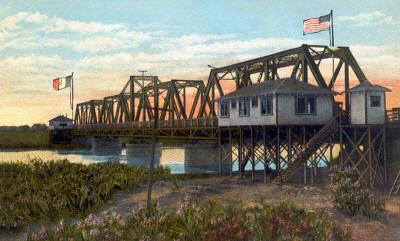|
Old
is good, especially when it's a freshly discovered newspaper from
April 1929. It's exciting to read things that happened even before
the stock market crash was to occur that coming October, leading America
into one of the bleakest periods in our history. That sad period also
saw the close of the oldest institution on the lower Mexican border:
the Brownsville-Metamoros
ferry.
The ferry (chalon) was an efficient means of transportation between
the U.S. and Mexico
for 110 years, but in 1929, it took its last trip across the Rio Grande.
|
Ferry Landing,
Brownsville,
Texas in 1910
Postcard courtesy www.rootsweb.com/ %7Etxpstcrd/ |
No
records exist of the very first ferry between Matamoros and Matamors
Commons (now the City
of Brownsville); it is believed to have occurred sometime in 1818,
or about the same time as the founding of Congregation del Refugio.
In 1826 when the Congregation del Refugio reorganized and took the
name of Matamoros, the ferry was operating as the Anaquitas ferry
to the Matamors
Commons.
It was at the site of this ferry that, in 1846, over 100 Mexican soldiers
were drowned while retreating from General Zachary Taylor's soldiers.
In 1850, Brownsville
became the outfitting post for hundreds of goldseekers (and possibly
gold diggers as well) headed for the gold mines in California.
During the Civil War, thousands of bales of Southern cotton
were brought through this port for shipment to Europe, millions of
dollars worth of supplies for the Army of the South crossed at this
point. After the Civil War when supplies for most of northern Mexico
flowed through this port by way of Point Isabel over the Rio Grande
Railway, the freight ferry continued to handle a "vast tonnage." |
 |
The International
Bridge connecting Brownsville
with Matamoros
Postcard courtesy texasoldphotos.com |
An
ever-growing population eventually replaced this historic ferry with
a steel bridge. Today, the Brownsville-Metamoros
Bridge is listed by Homeland Security as one of the prime land border
ports of entry into the United States.
Without knowing the history of these two great nations, we deprive
only ourselves. Be sure to check out stories like this one when you
plan your summer vacation. Old is good.
© Maggie
Van Ostrand
"A Balloon In Cactus" June
19, 2010 column |
Historical
Marker
In Hope Park, 14th and Levee Street, Brownsville,
Texas
Brownsville-Matamoros
Ferries and River Boardwalk
"Ferry service
along this stretch of the Rio Grande evolved as population in the
area increased. In 1836, General Jose Urrea used rowboats at the Paso
Real ferry near the later site of Fort Brown en route to Goliad.
General Vicente Filisola used the same service on his retreat from
the Battle
of San Jacinto.
Charles Stillman, a Matamoros merchant and businessman, and his estate
owned most of the ferry operations near this site from about 1846.
The three main ferry ports were located at newly emerging Brownsville,
Anacuitas (also called Paso Libre, then Shannondale and later Freeport)
and Mansfield. Brownsville
and Matamoros were integral to one another and the ferries were a
lifeline between them.
During the Civil War, the Confederates used ferries to transport cotton
to Mexico while
southern ports were blockaded by the Union Navy. During Union occupation
of Brownsville
in 1863, the banks of the Rio Grande were teeming with families waiting
to cross the river into exile in Mexico.
In the 1880s the ferry company built a plank walk from the railroad
tracks to the Brownsville
ferry dock because of complaints from passengers who had tired of
walking through six inches or more of mud. The walk expanded as the
ferry dock relocated several times, and soon the space was filled
with a variety of shops catering to the bustling crowds of travelers.
The Brownsville-Matamoros
bridge was erected in 1910, but for a time only freight traffic on
the river decreased. When the gateway bridge was built in 1928, the
need for ferryboats vanished, and the boardwalk, by this time as much
a part of local life as the river itself, vanished with them.
(2000) |
|
Popular Columns
by Maggie Van Ostrand |
|
